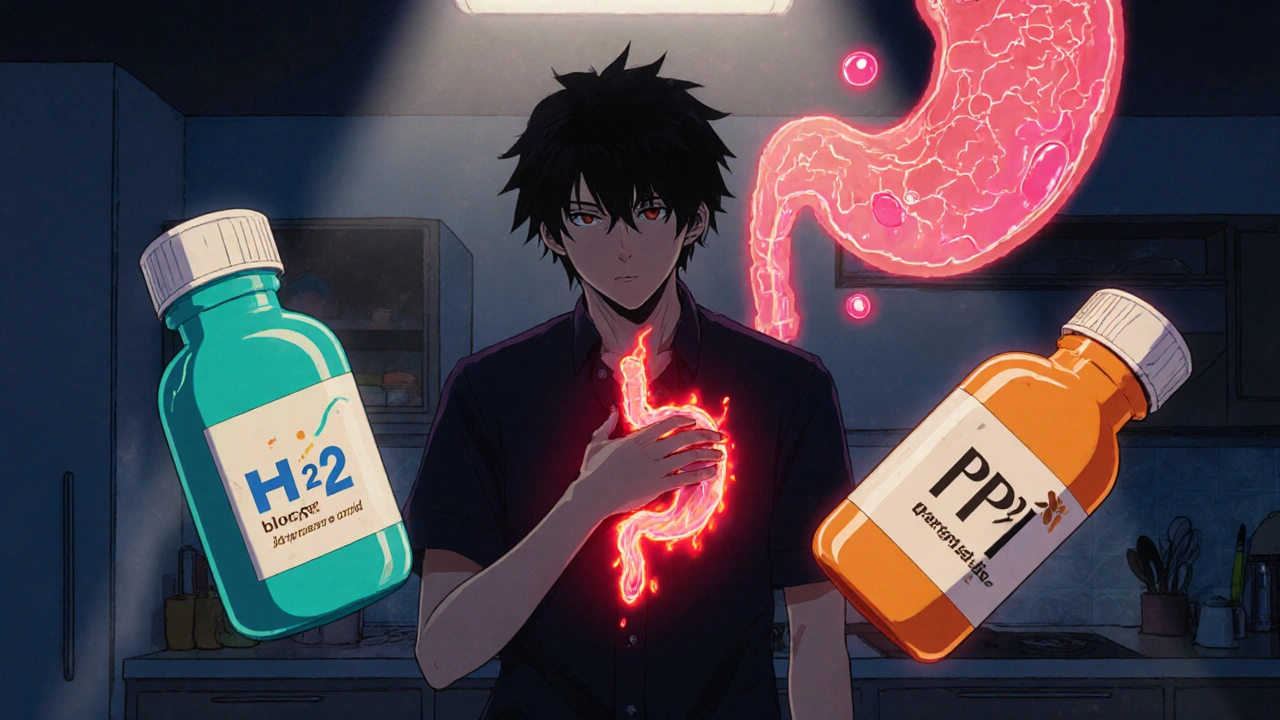Combination Therapy Decision Tool
Assess Your Case
This tool helps determine if combination therapy with an H2 blocker and PPI is appropriate based on clinical guidelines.
Your Assessment
Mixing an H2 blocker a medication that blocks histamine H2 receptors on stomach cells to lower acid with a Proton Pump Inhibitor a drug that irreversibly shuts down the H+/K+ ATPase pump, cutting acid output dramatically might sound like a double‑punch against heartburn, but the science tells a more nuanced story. Below you’ll find the key facts, the latest evidence, and practical steps to decide when (or whether) to pair these two drug families.
Quick Takeaways
- H2 blockers reduce acid by 50‑70% and act within an hour; PPIs cut 90‑98% of secretion but need 2‑5 days to peak.
- Combo therapy offers only a modest 5% extra acid reduction in GERD and is rarely justified.
- Combination use is linked to higher rates of hospital‑acquired pneumonia, C. difficile infection, and kidney disease progression.
- Guidelines reserve dual therapy for documented nocturnal acid breakthrough after optimal PPI dosing.
- Regular "PPI time‑out" reviews and clear documentation can prevent unnecessary exposure.
How H2 Blockers and PPIs Work - A Side‑by‑Side Look
Both drug classes target the same end point-less stomach acid-but they hit different switches.
Cimetidine one of the first H2 blockers, approved in 1977 and its newer cousin Famotidine approved in 1986, offers a cleaner interaction profile sit on the histamine‑2 receptors of parietal cells. By blocking histamine, they blunt the signal that tells the cell to pump out acid. The effect peaks in about an hour and wanes after 6‑12 hours.
In contrast, a classic Omeprazole the first PPI on the market, FDA‑approved in 1989 (and its relatives Esomeprazole and Pantoprazole) binds covalently to the H+/K+ ATPase pump. The binding is irreversible, so each pump stays off until the cell makes a new one-usually 24 hours later. Because the pump only works when the stomach is actively secreting acid, PPIs need several doses to catch enough active pumps, which explains the 2‑5 day lag to full effect.
What the Evidence Says About Combining the Two
In theory, layering a fast‑acting H2 blocker on top of a long‑acting PPI could mop up any “break‑through” acid that slips through at night. Real‑world data, however, tells a different tale.
A 2022 trial by Katz et al. added Ranitidine an older H2 blocker withdrawn in many markets for NDMA concerns to patients already on Omeprazole. The combination shaved off only about 5 % more 24‑hour acid exposure, with no meaningful daytime benefit and a slight night‑time edge that vanished after 4‑6 weeks.
Guideline bodies have taken note. The American College of Gastroenterology (2022) concluded that “long‑term combination therapy offers no additional benefit for routine GERD management.” The American Gastroenterological Association (2021) echoed the sentiment, urging clinicians to avoid the combo except for short‑term, documented nocturnal breakthrough.

Safety Red Flags - Why More Isn’t Always Better
Beyond the modest efficacy gain, safety data raise serious concerns.
In a landmark JAMA Internal Medicine analysis of nearly 80 000 ICU patients, PPI users faced a 30 % higher adjusted odds of hospital‑acquired pneumonia and a 32 % higher odds of Clostridium difficile infection compared with patients on H2 blockers alone. The same study noted a 22 % rise in gastrointestinal bleeding rates among PPI recipients.
Kidney health is another domain where PPIs lag. A 2021 BMC Nephrology cohort showed a 28 % increased hazard of progressing to end‑stage kidney disease for patients taking PPIs versus H2 blockers, after a median follow‑up of 4.2 years.
Drug‑drug interactions add another layer. Older H2 blockers like Cimetidine inhibit cytochrome P450 enzymes, potentially raising serum levels of co‑prescribed PPIs and other drugs. Newer agents such as Famotidine have a cleaner metabolic profile, but the interaction risk is still a consideration when stacking multiple acid‑suppressors.
When (If Ever) to Use Both
Guidelines narrow the indication to a very specific scenario: documented nocturnal acid breakthrough after maximized PPI dosing, confirmed by 24‑hour pH monitoring that shows an intragastric pH < 4 for >60 minutes between midnight and 6 am.
If that picture fits, the recommended approach is:
- Continue the twice‑daily PPI at the highest approved dose.
- Add an H2 blocker (e.g., famotidine 20 mg) at bedtime for 4‑8 weeks.
- Re‑assess symptoms and repeat pH testing.
- If no improvement, discontinue the H2 blocker and explore alternative strategies (dietary mod, alginate therapy, or surgical referral).
Short‑term use (generally under 2 months) is emphasized to avoid cumulative side‑effect burden.
Practical Tips for Clinicians
- Document the indication. Write “nocturnal acid breakthrough confirmed by pH study” in the chart.
- Set a PPI time‑out. Review the need every 90 days, as recommended by the VA Clinical Practice Guideline.
- Choose the safest H2 blocker. Famotidine or ranitidine (where still available) have minimal CYP450 interaction.
- Watch for red flags. New onset cough, unexplained anemia, or recurrent C. difficile should prompt medication review.
- Educate patients. Explain that “acid‑buster” combos are not a lifelong solution and that tapering may be needed.

Deprescribing and Ongoing Monitoring
Many patients end up on chronic dual therapy without a clear reason. A systematic deprescribing protocol can reclaim safety and cut costs.
- Identify all patients on both classes via pharmacy reports.
- Check for recent pH monitoring or documented nocturnal symptoms.
- If none, taper the H2 blocker first (reduce dose by 50 % weekly).
- After H2 blocker cessation, reassess the need for the PPI; consider step‑down to the lowest effective dose or switch to an H2 blocker alone.
- Document each step and schedule follow‑up within 4‑6 weeks.
This approach aligns with the Choosing Wisely recommendation to avoid routine combination therapy for GERD.
Comparison Table: Key Differences Between H2 Blockers and PPIs
| Attribute | H2 Blockers | PPIs |
|---|---|---|
| Primary Mechanism | Blocks histamine‑2 receptors on parietal cells | Irreversibly inhibits H+/K+ ATPase proton pump |
| Onset of Action | ≈1 hour | 2‑5 days to peak effect |
| Acid Suppression | 50‑70 % | 90‑98 % |
| Typical Duration | 6‑12 hours | 24 hours (once‑daily dosing) |
| Key Safety Concerns | Rare CYP450 interactions (cimetidine) | Pneumonia, C. difficile, kidney disease progression, nutrient malabsorption |
| Cost (US 2023) | ~$0.10‑$0.30 per tablet | ~$0.25‑$0.50 per tablet |
Frequently Asked Questions
Do I need to take an H2 blocker if I’m already on a PPI?
Only if you have documented nocturnal acid breakthrough despite optimal PPI dosing. Otherwise, the extra drug adds cost and risk without clear benefit.
Can H2 blockers cause the same vitamin deficiencies as PPIs?
Vitamin B12 and magnesium deficiencies are mainly linked to prolonged, high‑dose PPI use. H2 blockers have a much lower impact on intestinal absorption.
What is the best H2 blocker to pair with a PPI?
Famotidine is preferred because it has minimal cytochrome P450 inhibition, making drug‑drug interactions less likely.
How often should I reassess the need for dual therapy?
Guidelines suggest a review every 90 days, with a formal “PPI time‑out” to confirm ongoing necessity.
Are there any patient groups that should avoid PPIs altogether?
Patients with chronic kidney disease, a history of C. difficile infection, or frequent respiratory infections may benefit from starting with an H2 blocker instead of a PPI.

